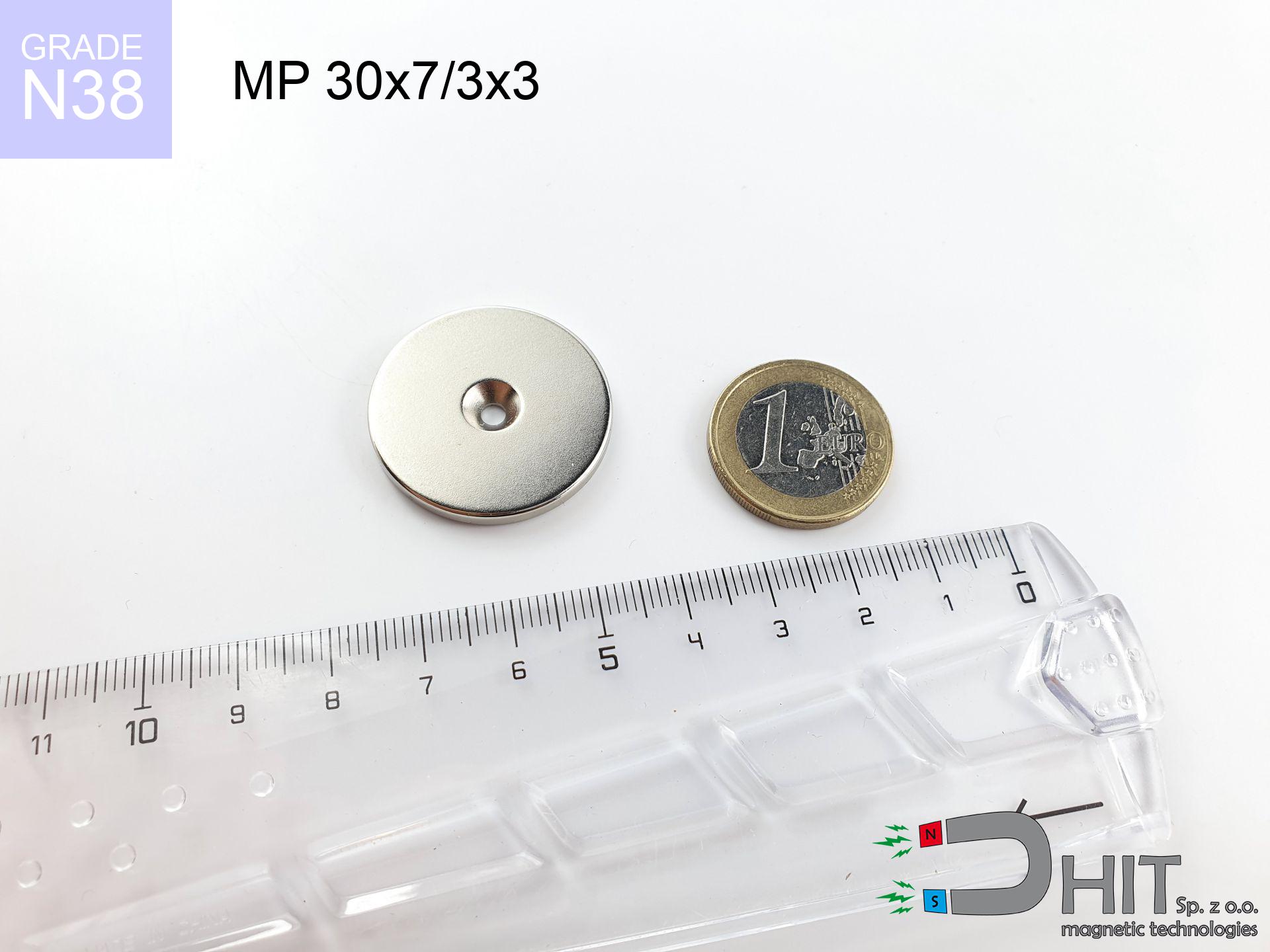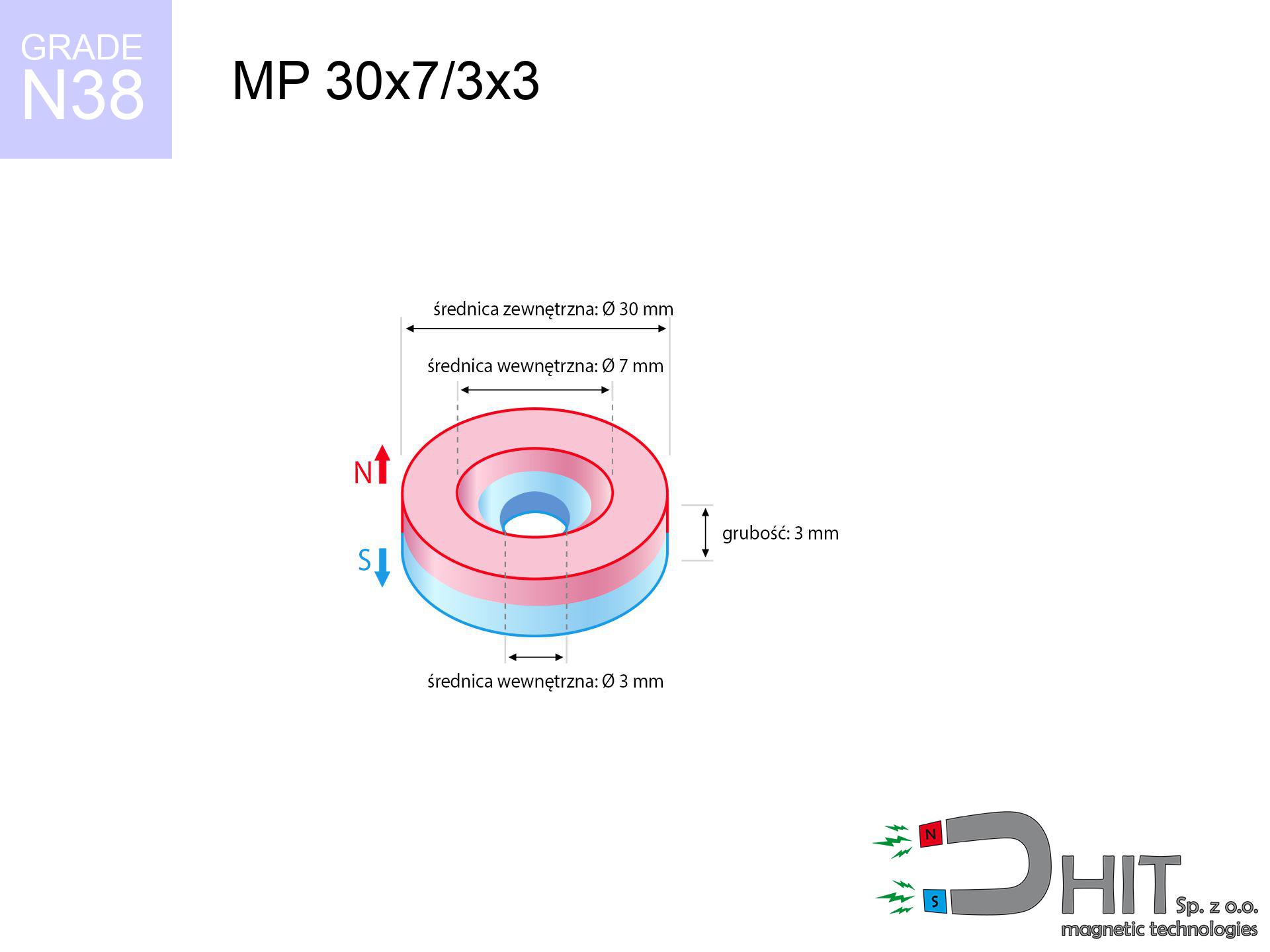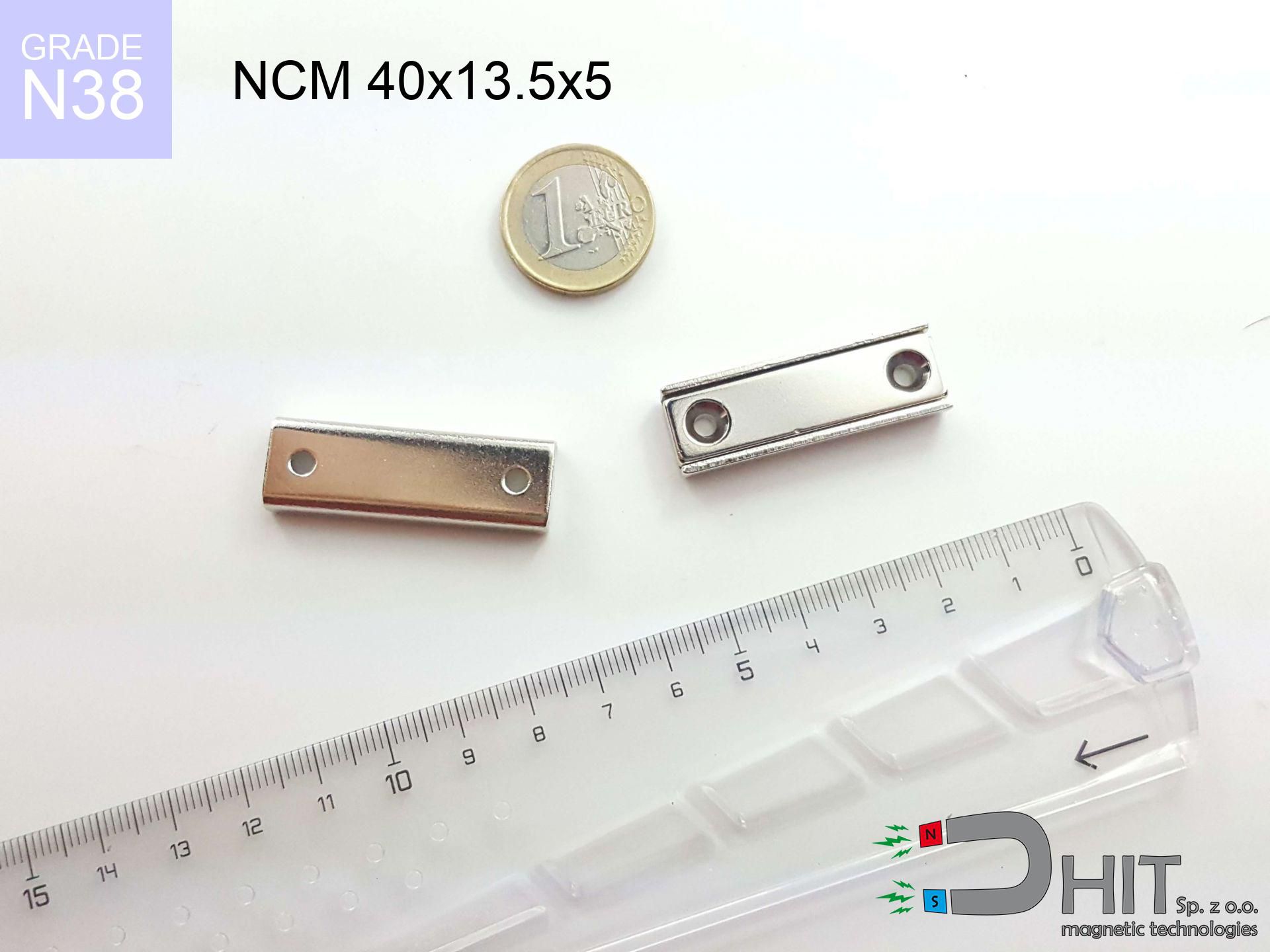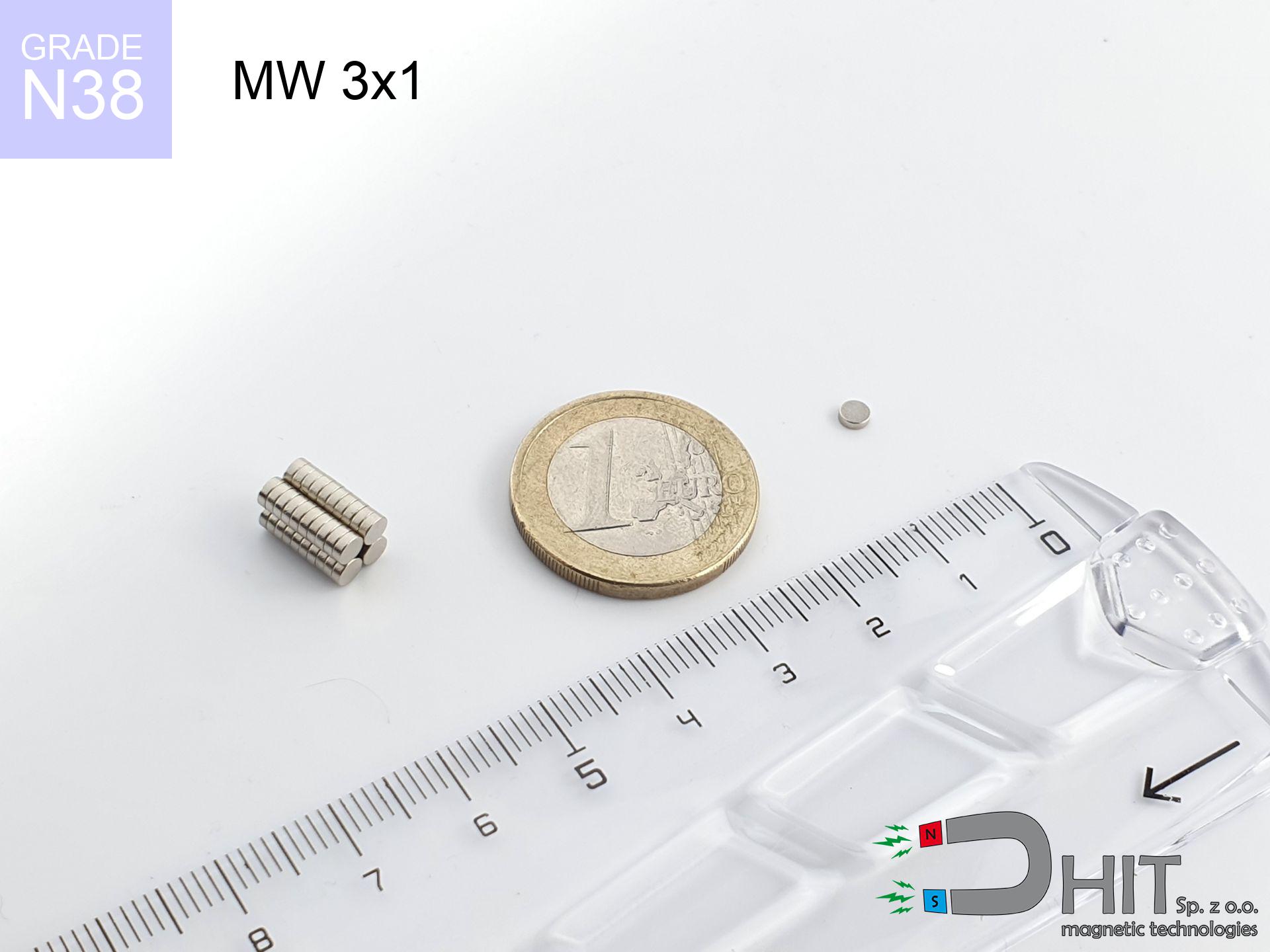MP 30x7/3x3 / N38 - ring magnet
ring magnet
Catalog no 030250
GTIN/EAN: 5906301812265
Diameter
30 mm [±0,1 mm]
internal diameter Ø
7/3 mm [±0,1 mm]
Height
3 mm [±0,1 mm]
Weight
15.75 g
Magnetization Direction
↑ axial
Load capacity
3.64 kg / 35.69 N
Magnetic Induction
121.58 mT / 1216 Gs
Coating
[NiCuNi] Nickel
6.84 ZŁ with VAT / pcs + price for transport
5.56 ZŁ net + 23% VAT / pcs
bulk discounts:
Need more?
Contact us by phone
+48 22 499 98 98
alternatively drop us a message via
inquiry form
the contact page.
Strength and appearance of magnetic components can be reviewed with our
force calculator.
Order by 14:00 and we’ll ship today!
Technical of the product - MP 30x7/3x3 / N38 - ring magnet
Specification / characteristics - MP 30x7/3x3 / N38 - ring magnet
| properties | values |
|---|---|
| Cat. no. | 030250 |
| GTIN/EAN | 5906301812265 |
| Production/Distribution | Dhit sp. z o.o. |
| Country of origin | Poland / China / Germany |
| Customs code | 85059029 |
| Diameter | 30 mm [±0,1 mm] |
| internal diameter Ø | 7/3 mm [±0,1 mm] |
| Height | 3 mm [±0,1 mm] |
| Weight | 15.75 g |
| Magnetization Direction | ↑ axial |
| Load capacity ~ ? | 3.64 kg / 35.69 N |
| Magnetic Induction ~ ? | 121.58 mT / 1216 Gs |
| Coating | [NiCuNi] Nickel |
| Manufacturing Tolerance | ±0.1 mm |
Magnetic properties of material N38
| properties | values | units |
|---|---|---|
| remenance Br [min. - max.] ? | 12.2-12.6 | kGs |
| remenance Br [min. - max.] ? | 1220-1260 | mT |
| coercivity bHc ? | 10.8-11.5 | kOe |
| coercivity bHc ? | 860-915 | kA/m |
| actual internal force iHc | ≥ 12 | kOe |
| actual internal force iHc | ≥ 955 | kA/m |
| energy density [min. - max.] ? | 36-38 | BH max MGOe |
| energy density [min. - max.] ? | 287-303 | BH max KJ/m |
| max. temperature ? | ≤ 80 | °C |
Physical properties of sintered neodymium magnets Nd2Fe14B at 20°C
| properties | values | units |
|---|---|---|
| Vickers hardness | ≥550 | Hv |
| Density | ≥7.4 | g/cm3 |
| Curie Temperature TC | 312 - 380 | °C |
| Curie Temperature TF | 593 - 716 | °F |
| Specific resistance | 150 | μΩ⋅cm |
| Bending strength | 250 | MPa |
| Compressive strength | 1000~1100 | MPa |
| Thermal expansion parallel (∥) to orientation (M) | (3-4) x 10-6 | °C-1 |
| Thermal expansion perpendicular (⊥) to orientation (M) | -(1-3) x 10-6 | °C-1 |
| Young's modulus | 1.7 x 104 | kg/mm² |
Physical simulation of the product - technical parameters
These values constitute the direct effect of a engineering analysis. Results rely on algorithms for the material Nd2Fe14B. Real-world performance might slightly deviate from the simulation results. Treat these data as a supplementary guide for designers.
Table 1: Static force (force vs gap) - power drop
MP 30x7/3x3 / N38
| Distance (mm) | Induction (Gauss) / mT | Pull Force (kg/lbs/g/N) | Risk Status |
|---|---|---|---|
| 0 mm |
1039 Gs
103.9 mT
|
3.64 kg / 8.02 LBS
3640.0 g / 35.7 N
|
warning |
| 1 mm |
1015 Gs
101.5 mT
|
3.48 kg / 7.67 LBS
3477.6 g / 34.1 N
|
warning |
| 2 mm |
980 Gs
98.0 mT
|
3.24 kg / 7.14 LBS
3240.7 g / 31.8 N
|
warning |
| 3 mm |
936 Gs
93.6 mT
|
2.95 kg / 6.51 LBS
2951.6 g / 29.0 N
|
warning |
| 5 mm |
827 Gs
82.7 mT
|
2.31 kg / 5.08 LBS
2305.8 g / 22.6 N
|
warning |
| 10 mm |
539 Gs
53.9 mT
|
0.98 kg / 2.16 LBS
981.0 g / 9.6 N
|
low risk |
| 15 mm |
329 Gs
32.9 mT
|
0.37 kg / 0.80 LBS
365.1 g / 3.6 N
|
low risk |
| 20 mm |
202 Gs
20.2 mT
|
0.14 kg / 0.30 LBS
137.9 g / 1.4 N
|
low risk |
| 30 mm |
85 Gs
8.5 mT
|
0.02 kg / 0.05 LBS
24.6 g / 0.2 N
|
low risk |
| 50 mm |
23 Gs
2.3 mT
|
0.00 kg / 0.00 LBS
1.8 g / 0.0 N
|
low risk |
Table 2: Sliding load (vertical surface)
MP 30x7/3x3 / N38
| Distance (mm) | Friction coefficient | Pull Force (kg/lbs/g/N) |
|---|---|---|
| 0 mm | Stal (~0.2) |
0.73 kg / 1.60 LBS
728.0 g / 7.1 N
|
| 1 mm | Stal (~0.2) |
0.70 kg / 1.53 LBS
696.0 g / 6.8 N
|
| 2 mm | Stal (~0.2) |
0.65 kg / 1.43 LBS
648.0 g / 6.4 N
|
| 3 mm | Stal (~0.2) |
0.59 kg / 1.30 LBS
590.0 g / 5.8 N
|
| 5 mm | Stal (~0.2) |
0.46 kg / 1.02 LBS
462.0 g / 4.5 N
|
| 10 mm | Stal (~0.2) |
0.20 kg / 0.43 LBS
196.0 g / 1.9 N
|
| 15 mm | Stal (~0.2) |
0.07 kg / 0.16 LBS
74.0 g / 0.7 N
|
| 20 mm | Stal (~0.2) |
0.03 kg / 0.06 LBS
28.0 g / 0.3 N
|
| 30 mm | Stal (~0.2) |
0.00 kg / 0.01 LBS
4.0 g / 0.0 N
|
| 50 mm | Stal (~0.2) |
0.00 kg / 0.00 LBS
0.0 g / 0.0 N
|
Table 3: Vertical assembly (sliding) - behavior on slippery surfaces
MP 30x7/3x3 / N38
| Surface type | Friction coefficient / % Mocy | Max load (kg/lbs/g/N) |
|---|---|---|
| Raw steel |
µ = 0.3
30% Nominalnej Siły
|
1.09 kg / 2.41 LBS
1092.0 g / 10.7 N
|
| Painted steel (standard) |
µ = 0.2
20% Nominalnej Siły
|
0.73 kg / 1.60 LBS
728.0 g / 7.1 N
|
| Oily/slippery steel |
µ = 0.1
10% Nominalnej Siły
|
0.36 kg / 0.80 LBS
364.0 g / 3.6 N
|
| Magnet with anti-slip rubber |
µ = 0.5
50% Nominalnej Siły
|
1.82 kg / 4.01 LBS
1820.0 g / 17.9 N
|
Table 4: Material efficiency (saturation) - sheet metal selection
MP 30x7/3x3 / N38
| Steel thickness (mm) | % power | Real pull force (kg/lbs/g/N) |
|---|---|---|
| 0.5 mm |
|
0.36 kg / 0.80 LBS
364.0 g / 3.6 N
|
| 1 mm |
|
0.91 kg / 2.01 LBS
910.0 g / 8.9 N
|
| 2 mm |
|
1.82 kg / 4.01 LBS
1820.0 g / 17.9 N
|
| 3 mm |
|
2.73 kg / 6.02 LBS
2730.0 g / 26.8 N
|
| 5 mm |
|
3.64 kg / 8.02 LBS
3640.0 g / 35.7 N
|
| 10 mm |
|
3.64 kg / 8.02 LBS
3640.0 g / 35.7 N
|
| 11 mm |
|
3.64 kg / 8.02 LBS
3640.0 g / 35.7 N
|
| 12 mm |
|
3.64 kg / 8.02 LBS
3640.0 g / 35.7 N
|
Table 5: Working in heat (material behavior) - thermal limit
MP 30x7/3x3 / N38
| Ambient temp. (°C) | Power loss | Remaining pull (kg/lbs/g/N) | Status |
|---|---|---|---|
| 20 °C | 0.0% |
3.64 kg / 8.02 LBS
3640.0 g / 35.7 N
|
OK |
| 40 °C | -2.2% |
3.56 kg / 7.85 LBS
3559.9 g / 34.9 N
|
OK |
| 60 °C | -4.4% |
3.48 kg / 7.67 LBS
3479.8 g / 34.1 N
|
|
| 80 °C | -6.6% |
3.40 kg / 7.50 LBS
3399.8 g / 33.4 N
|
|
| 100 °C | -28.8% |
2.59 kg / 5.71 LBS
2591.7 g / 25.4 N
|
Table 6: Magnet-Magnet interaction (attraction) - forces in the system
MP 30x7/3x3 / N38
| Gap (mm) | Attraction (kg/lbs) (N-S) | Shear Force (kg/lbs/g/N) | Repulsion (kg/lbs) (N-N) |
|---|---|---|---|
| 0 mm |
3.96 kg / 8.73 LBS
1 995 Gs
|
0.59 kg / 1.31 LBS
594 g / 5.8 N
|
N/A |
| 1 mm |
3.88 kg / 8.56 LBS
2 058 Gs
|
0.58 kg / 1.28 LBS
582 g / 5.7 N
|
3.49 kg / 7.70 LBS
~0 Gs
|
| 2 mm |
3.78 kg / 8.34 LBS
2 031 Gs
|
0.57 kg / 1.25 LBS
567 g / 5.6 N
|
3.40 kg / 7.50 LBS
~0 Gs
|
| 3 mm |
3.66 kg / 8.07 LBS
1 998 Gs
|
0.55 kg / 1.21 LBS
549 g / 5.4 N
|
3.30 kg / 7.26 LBS
~0 Gs
|
| 5 mm |
3.37 kg / 7.43 LBS
1 918 Gs
|
0.51 kg / 1.12 LBS
506 g / 5.0 N
|
3.04 kg / 6.69 LBS
~0 Gs
|
| 10 mm |
2.51 kg / 5.53 LBS
1 654 Gs
|
0.38 kg / 0.83 LBS
376 g / 3.7 N
|
2.26 kg / 4.97 LBS
~0 Gs
|
| 20 mm |
1.07 kg / 2.35 LBS
1 079 Gs
|
0.16 kg / 0.35 LBS
160 g / 1.6 N
|
0.96 kg / 2.12 LBS
~0 Gs
|
| 50 mm |
0.06 kg / 0.13 LBS
258 Gs
|
0.01 kg / 0.02 LBS
9 g / 0.1 N
|
0.05 kg / 0.12 LBS
~0 Gs
|
| 60 mm |
0.03 kg / 0.06 LBS
171 Gs
|
0.00 kg / 0.01 LBS
4 g / 0.0 N
|
0.02 kg / 0.05 LBS
~0 Gs
|
| 70 mm |
0.01 kg / 0.03 LBS
118 Gs
|
0.00 kg / 0.00 LBS
2 g / 0.0 N
|
0.01 kg / 0.03 LBS
~0 Gs
|
| 80 mm |
0.01 kg / 0.01 LBS
84 Gs
|
0.00 kg / 0.00 LBS
1 g / 0.0 N
|
0.00 kg / 0.00 LBS
~0 Gs
|
| 90 mm |
0.00 kg / 0.01 LBS
62 Gs
|
0.00 kg / 0.00 LBS
1 g / 0.0 N
|
0.00 kg / 0.00 LBS
~0 Gs
|
| 100 mm |
0.00 kg / 0.00 LBS
47 Gs
|
0.00 kg / 0.00 LBS
0 g / 0.0 N
|
0.00 kg / 0.00 LBS
~0 Gs
|
Table 7: Hazards (implants) - warnings
MP 30x7/3x3 / N38
| Object / Device | Limit (Gauss) / mT | Safe distance |
|---|---|---|
| Pacemaker | 5 Gs (0.5 mT) | 9.0 cm |
| Hearing aid | 10 Gs (1.0 mT) | 7.0 cm |
| Timepiece | 20 Gs (2.0 mT) | 5.5 cm |
| Mobile device | 40 Gs (4.0 mT) | 4.5 cm |
| Remote | 50 Gs (5.0 mT) | 4.0 cm |
| Payment card | 400 Gs (40.0 mT) | 1.5 cm |
| HDD hard drive | 600 Gs (60.0 mT) | 1.0 cm |
Table 8: Dynamics (cracking risk) - collision effects
MP 30x7/3x3 / N38
| Start from (mm) | Speed (km/h) | Energy (J) | Predicted outcome |
|---|---|---|---|
| 10 mm |
17.73 km/h
(4.92 m/s)
|
0.19 J | |
| 30 mm |
26.67 km/h
(7.41 m/s)
|
0.43 J | |
| 50 mm |
34.29 km/h
(9.53 m/s)
|
0.71 J | |
| 100 mm |
48.48 km/h
(13.47 m/s)
|
1.43 J |
Table 9: Surface protection spec
MP 30x7/3x3 / N38
| Technical parameter | Value / Description |
|---|---|
| Coating type | [NiCuNi] Nickel |
| Layer structure | Nickel - Copper - Nickel |
| Layer thickness | 10-20 µm |
| Salt spray test (SST) ? | 24 h |
| Recommended environment | Indoors only (dry) |
Table 10: Electrical data (Flux)
MP 30x7/3x3 / N38
| Parameter | Value | SI Unit / Description |
|---|---|---|
| Magnetic Flux | 8 395 Mx | 84.0 µWb |
| Pc Coefficient | 0.13 | Low (Flat) |
Table 11: Underwater work (magnet fishing)
MP 30x7/3x3 / N38
| Environment | Effective steel pull | Effect |
|---|---|---|
| Air (land) | 3.64 kg | Standard |
| Water (riverbed) |
4.17 kg
(+0.53 kg buoyancy gain)
|
+14.5% |
1. Sliding resistance
*Caution: On a vertical surface, the magnet retains just ~20% of its nominal pull.
2. Steel saturation
*Thin steel (e.g. 0.5mm PC case) significantly reduces the holding force.
3. Thermal stability
*For N38 material, the safety limit is 80°C.
4. Demagnetization curve and operating point (B-H)
chart generated for the permeance coefficient Pc (Permeance Coefficient) = 0.13
This simulation demonstrates the magnetic stability of the selected magnet under specific geometric conditions. The solid red line represents the demagnetization curve (material potential), while the dashed blue line is the load line based on the magnet's geometry. The Pc (Permeance Coefficient), also known as the load line slope, is a dimensionless value that describes the relationship between the magnet's shape and its magnetic stability. The intersection of these two lines (the black dot) is the operating point — it determines the actual magnetic flux density generated by the magnet in this specific configuration. A higher Pc value means the magnet is more 'slender' (tall relative to its area), resulting in a higher operating point and better resistance to irreversible demagnetization caused by external fields or temperature. A value of 0.42 is relatively low (typical for flat magnets), meaning the operating point is closer to the 'knee' of the curve — caution is advised when operating at temperatures near the maximum limit to avoid strength loss.
Chemical composition
| iron (Fe) | 64% – 68% |
| neodymium (Nd) | 29% – 32% |
| boron (B) | 1.1% – 1.2% |
| dysprosium (Dy) | 0.5% – 2.0% |
| coating (Ni-Cu-Ni) | < 0.05% |
Sustainability
| recyclability (EoL) | 100% |
| recycled raw materials | ~10% (pre-cons) |
| carbon footprint | low / zredukowany |
| waste code (EWC) | 16 02 16 |
Other offers
Advantages and disadvantages of rare earth magnets.
Benefits
- They do not lose power, even after approximately ten years – the decrease in power is only ~1% (according to tests),
- Magnets very well protect themselves against loss of magnetization caused by external fields,
- A magnet with a shiny gold surface is more attractive,
- Magnetic induction on the surface of the magnet remains very high,
- Due to their durability and thermal resistance, neodymium magnets can operate (depending on the form) even at high temperatures reaching 230°C or more...
- Possibility of custom shaping and adapting to individual requirements,
- Fundamental importance in modern industrial fields – they are commonly used in mass storage devices, motor assemblies, medical devices, and modern systems.
- Thanks to their power density, small magnets offer high operating force, with minimal size,
Weaknesses
- To avoid cracks under impact, we suggest using special steel housings. Such a solution protects the magnet and simultaneously increases its durability.
- When exposed to high temperature, neodymium magnets experience a drop in strength. Often, when the temperature exceeds 80°C, their strength decreases (depending on the size, as well as shape of the magnet). For those who need magnets for extreme conditions, we offer [AH] versions withstanding up to 230°C
- When exposed to humidity, magnets start to rust. To use them in conditions outside, it is recommended to use protective magnets, such as those in rubber or plastics, which prevent oxidation as well as corrosion.
- We recommend casing - magnetic mechanism, due to difficulties in creating nuts inside the magnet and complex shapes.
- Potential hazard to health – tiny shards of magnets are risky, if swallowed, which becomes key in the context of child safety. Furthermore, small elements of these magnets can complicate diagnosis medical after entering the body.
- High unit price – neodymium magnets have a higher price than other types of magnets (e.g. ferrite), which can limit application in large quantities
Holding force characteristics
Highest magnetic holding force – what affects it?
- on a plate made of mild steel, effectively closing the magnetic field
- with a thickness minimum 10 mm
- with an ideally smooth contact surface
- without any insulating layer between the magnet and steel
- under perpendicular force direction (90-degree angle)
- at ambient temperature room level
Determinants of practical lifting force of a magnet
- Distance – the presence of foreign body (rust, tape, air) acts as an insulator, which reduces power steeply (even by 50% at 0.5 mm).
- Loading method – catalog parameter refers to pulling vertically. When slipping, the magnet holds significantly lower power (often approx. 20-30% of nominal force).
- Base massiveness – insufficiently thick sheet causes magnetic saturation, causing part of the flux to be escaped into the air.
- Chemical composition of the base – low-carbon steel attracts best. Higher carbon content decrease magnetic properties and lifting capacity.
- Surface quality – the more even the plate, the better the adhesion and stronger the hold. Unevenness acts like micro-gaps.
- Thermal conditions – neodymium magnets have a negative temperature coefficient. When it is hot they are weaker, and in frost gain strength (up to a certain limit).
Lifting capacity was determined by applying a smooth steel plate of optimal thickness (min. 20 mm), under vertically applied force, whereas under shearing force the holding force is lower. Moreover, even a slight gap between the magnet’s surface and the plate lowers the load capacity.
H&S for magnets
Choking Hazard
NdFeB magnets are not intended for children. Eating several magnets may result in them pinching intestinal walls, which constitutes a critical condition and necessitates urgent medical intervention.
Compass and GPS
GPS units and mobile phones are highly susceptible to magnetic fields. Close proximity with a powerful NdFeB magnet can ruin the internal compass in your phone.
Thermal limits
Do not overheat. Neodymium magnets are sensitive to heat. If you require operation above 80°C, look for HT versions (H, SH, UH).
Handling guide
Before starting, check safety instructions. Sudden snapping can break the magnet or injure your hand. Be predictive.
Skin irritation risks
Nickel alert: The Ni-Cu-Ni coating contains nickel. If redness occurs, immediately stop working with magnets and use protective gear.
Finger safety
Protect your hands. Two large magnets will snap together instantly with a force of massive weight, crushing everything in their path. Exercise extreme caution!
Magnet fragility
Despite the nickel coating, neodymium is delicate and cannot withstand shocks. Avoid impacts, as the magnet may crumble into hazardous fragments.
Cards and drives
Do not bring magnets close to a wallet, computer, or screen. The magnetic field can destroy these devices and erase data from cards.
Do not drill into magnets
Machining of NdFeB material poses a fire risk. Neodymium dust oxidizes rapidly with oxygen and is hard to extinguish.
Life threat
Warning for patients: Strong magnetic fields disrupt electronics. Keep at least 30 cm distance or ask another person to work with the magnets.




![AM szekla [M10] - magnetic accessories AM szekla [M10] - magnetic accessories](https://cdn3.dhit.pl/graphics/products/am-szekla-m10-zeh.jpg)
![HH 25x7.7 [M5] / N38 - through hole magnetic holder HH 25x7.7 [M5] / N38 - through hole magnetic holder](https://cdn3.dhit.pl/graphics/products/hh-25x7.7-m5-pov.jpg)



